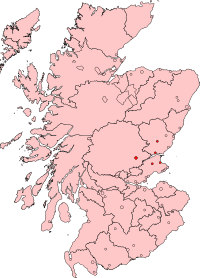Perth Burghs was a district of burghs constituency of the House of Commons of the Parliament of Great Britain (at Westminster) from 1708 to 1801 and of the Parliament of the United Kingdom (also at Westminster) from 1801 until 1832, representing a seat for one Member of Parliament (MP)
Boundaries
The constituency covered five burghs: Perth in the county of Perth, Cupar and St Andrews in the county of Fife, and Dundee and Forfar in the county of Forfar.
For the 1832 general election, as a result of the Representation of the People (Scotland) Act 1832, the burgh of Perth was merged into the new Perth burgh constituency, the burghs of Cupar and St Andrews were merged into the Fife county constituency, the burgh of Dundee was merged into new Dundee burgh constituency, and the burgh of Forfar was merged into the new Montrose Burghs constituency.
Member of Parliament
Election results
The electoral system for this constituency gave each of the five burghs one vote, with an additional casting vote (to break ties) for the burgh where the election was held. The place of election rotated amongst the burghs in successive Parliaments. The vote of a burgh was exercised by a burgh commissioner, who was elected by the burgh councillors.
The normal order of rotation for this district was Perth, Dundee, St Andrews, Cupar and Forfar. However the Court of Session had the power to suspend the participation of a burgh, as a punishment for corruption, which could disrupt the rotation if the normal returning burgh was not able to participate.[2]
At the time of the disputed elections in 1830 and 1831, Dundee was not able to take part in the voting. Although Dundee was not the returning burgh for the 1830-31 Parliament, its absence made the elections less certain and encouraged wrongdoing by candidates.[3]
The reference to some candidates as Non Partisan does not, necessarily, mean that they did not have a party allegiance. It means that the sources consulted did not specify a party allegiance. The sources used were Stooks Smith as well as Namier and Brooke (see the References section for further details).
Elections in the 18th century
Elections in the 1710s
Elections in the 1720s
- This election resulted in a double return of both candidates. The House of Commons seated Erskine.
Elections in the 1730s
Elections in the 1740s
- December 1743: Death of Drummond
Notes
References
|
|---|
| | | | |
- Aberdeen North
- Aberdeen South
- Airdrie & Shotts
- Angus
- Argyll & Bute
- Ayr, Carrick & Cumnock
- Banff & Buchan
- Berwickshire, Roxburgh & Selkirk
- Caithness, Sutherland & Easter Ross
- Central Ayrshire
- Coatbridge, Chryston & Bellshill
- Cumbernauld, Kilsyth & Kirkintilloch East
- Dumfries & Galloway
- Dumfriesshire, Clydesdale & Tweeddale
- Dundee East
- Dundee West
- Dunfermline & West Fife
- East Dunbartonshire
- East Kilbride, Strathaven & Lesmahagow
- East Lothian
- East Renfrewshire
- Edinburgh East
- Edinburgh North & Leith
- Edinburgh South
- Edinburgh South West
- Edinburgh West
- Falkirk
- Glasgow Central
- Glasgow East
- Glasgow North
- Glasgow North East
- Glasgow North West
- Glasgow South
- Glasgow South West
- Glenrothes
- Gordon
- Inverclyde
- Inverness, Nairn, Badenoch & Strathspey
- Kilmarnock & Loudoun
- Kirkcaldy & Cowdenbeath
- Lanark & Hamilton East
- Linlithgow & East Falkirk
- Livingston
- Midlothian
- Moray
- Motherwell & Wishaw
- Na h-Eileanan an Iar
- North Ayrshire & Arran
- North East Fife
- Ochil & South Perthshire
- Orkney & Shetland
- Paisley & Renfrewshire North
- Paisley & Renfrewshire South
- Perth & North Perthshire
- Ross, Skye & Lochaber
- Rutherglen & Hamilton West
- Stirling
- West Aberdeenshire & Kincardine
- West Dunbartonshire
|
|
